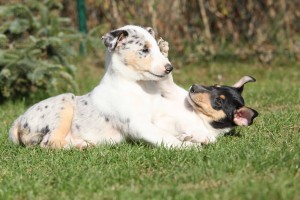 Socializing your new puppy is a vital aspect of pet ownership if you want to ensure that your dog grows up to be a well-adjusted canine citizen. Dogs who miss out on this aspect of basic training are more likely to reach adulthood with problems such as fearfulness, avoidance and aggressive behavior.
Socializing your new puppy is a vital aspect of pet ownership if you want to ensure that your dog grows up to be a well-adjusted canine citizen. Dogs who miss out on this aspect of basic training are more likely to reach adulthood with problems such as fearfulness, avoidance and aggressive behavior.
These tips will give you the basics you need to start socializing your puppy now.
#1: Start Young
The most important time to socialize your puppy is during the first three months of his (or her) life, according to the American Veterinary Society of Animal Behavior (AVSAB). During this period, a puppy’s sociability outweighs his fear, and he is more likely to adapt to meeting new people and animals and having new experiences.
At this age your puppy’s health is protected to a degree by her first set of vaccinations and the antibodies she gets from her mother. To minimize the risk of contracting diseases, however, it is best to do the socialization in a controlled environment such as a puppy class or a play date with friendly, vaccinated adult dogs and older puppies you are familiar with. We do not recommend dog parks at this stage.
#2: Keep it Positive
The whole purpose of puppy socialization is to make your new puppy feel good about the people he meets and the places you take him. To achieve this, his experience must be positive, so focus on making it as much fun as possible. Use praise and cuddles to enhance his enjoyment, and play with him to relax him when he’s nervous. Use treats sparingly as rewards, not as bribes, and don’t expose him to unfamiliar situations for such long periods that he becomes exhausted.
#3: Make it Varied
Provide variety in the form of introductions to people of all ages and ethnic backgrounds, so your puppy doesn’t grow up fearing children or members of another race. Introduce him to a variety of animals, including friendly cats, horses and livestock if you live out in the country, and any other pets you have such as hamsters, rabbits and birds. Keep a close eye on the interaction to ensure that nobody gets hurt.
#4: Watch for Bullies
There’s one in every group, and dogs are no different. Even in a class where you have only puppies under three months of age, it’s possible to find bullies. These are often bigger puppies or those that are slightly older than yours. They are frequently male puppies, although females can be pushy, too. While it’s unusual for a puppy to actively hurt another, even playing with a bigger, stronger and heavier pup can frighten your baby and cause her to develop a timidity that doesn’t disappear. Limit her interactions to other puppies with a similar disposition, and if yours is a bully don’t let her get away with it.
#5: Include Noises
Many dogs are terrified of sounds such as the vacuum cleaner, the doorbell, the sound of waves breaking on a beach, thunderstorms, and people laughing and talking loudly. Don’t wait until you notice your puppy reacting negatively to a sound to try and teach him not to fear it. Be proactive and identify the sounds he is likely to hear regularly during his life with you and expose him to them in stages. Play with him to distract him from becoming nervous of the sound and reward him when he responds to you instead of the noise.
#6: Traveling with your pet
At some point you’re going to need to travel with your puppy—trips to the veterinarian and elsewhere, and your life will be much easier if your furbaby is not cowering in your arms or under a seat. This is particularly important if you have a medium or large breed pup, because the time will come when you can no longer lift her up and hold her.
Adequate puppy socialization includes taking her on trains, subways, buses and, of course, in cars, so she gets accustomed to the sounds. Take her to a busy area such as the local mall, too, so she learns to associate the smell and sound of lots of people with a happy day out.
#7: Teach Basic Commands
Contrary to popular belief, it isn’t necessary to wait until a puppy is six months or older to start teaching basic commands. Reliable, trained dogs are less likely to stray and generally have an easier and less stressful life than untrained ones. Teach your puppy essentials such as:
- Come
- Sit
- Stay
- “No”
- Down
- Leave it
- Off
Use lots of praise, playbreaks and treats as a reward. You’ll find the training is fun and rewarding and helps to build your relationship with her.
Socializing your puppy properly is vital for good animal behavior, and doing it with positive reinforcement is the only way to get it right. If you’re unsure where to begin, our behavior consultations can help you to get started on the right track.

